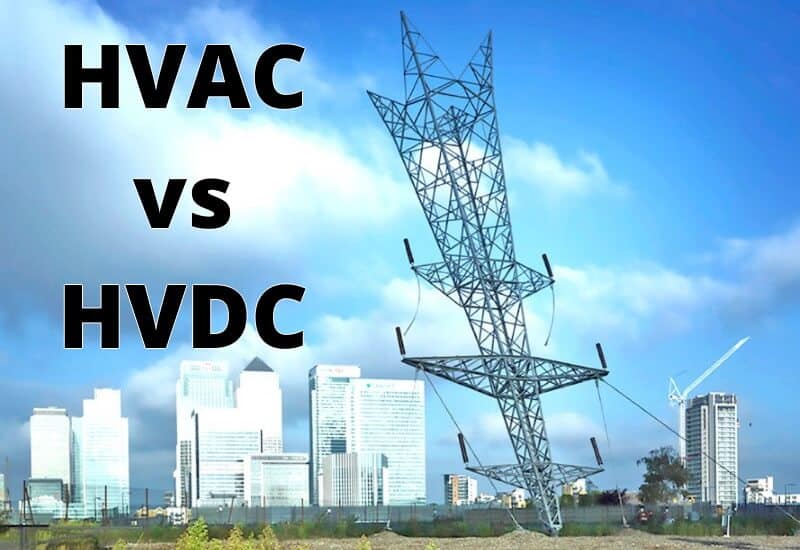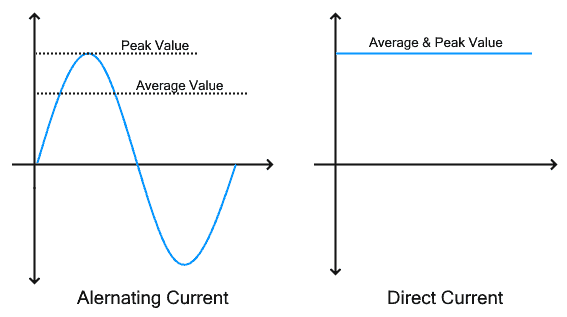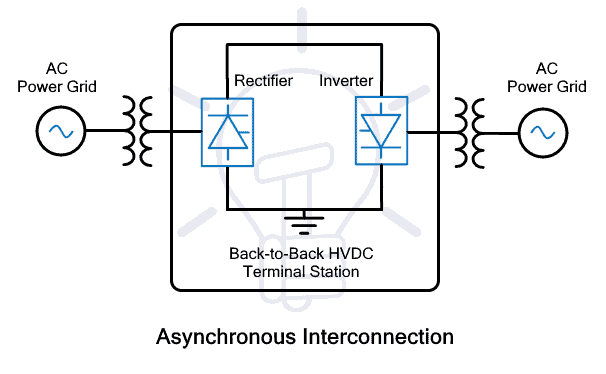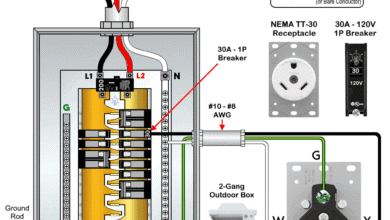Differences Between HVAC and HVDC – Power Transmission
Difference Between HVAC and HVDC
The electricity generated in a power generating stations is transmitted over long distances to reach an electrical substation which distributes it among the consumers. The voltage being used for long-distance power transmission is very high. We will get to the reason why it needs to be high voltage. Apart from that, the power transmitted can be either in AC (Alternating) or DC (Direct Current) form. Therefore, the power can be transmitted using either HVAC (High Voltage Alternating Current) or HVDC (High Voltage Direct Current).
Why High Voltage Necessary for Transmission?
The voltage plays a vital role in reducing the line losses also known as transmission losses. Every electrical conductor that we use for power transmission has some value of ohmic resistance R. These conductors generate heat energy when current I flow through it, which is actually the energy or Power P being wasted.
According to ohms law
V = I x R
Also the equation of power;
P = I x V
Putting the value of V = I x R
P = I x (I x R)
P = I2R
As you can see the energy wasted in a conductor during transmission depends on the current, not voltage. But we can use the voltage conversion using special equipment to increase or decrease the amount of current.
During the conversion of voltage, the power remains conserved & it does not change. Only the voltage & current decrease & increase by the same factor. That is;
P = I x V
For example, 11KW power at the voltage of 220v has 50 Amps in it. In such a case, the transmission line losses will be
P = I2R = (50)2R = 2500 R
Let’s increase the voltage by a factor of 10. So the same power of 11KW would have a voltage of 2200v & 5 Amps. Now the line losses would be;
P = (5)2R = 25 R
As you can see, increasing the voltage reduces the power losses significantly in transmissions lines.
So in order to decrease the current in the transmission cables while maintaining the same amount of power transmission, we increase the voltage.
- Related Post: Types of HVDC Systems and MTDC Configurations
The War of the Current (AC VS DC)
In earlier days, during the era of war of current (AC Vs. DC, late 1880s), The DC transmission was first introduced but it was considered very inefficient due to the lack of equipment for its voltage conversion such as a transformer which can easily convert AC voltages from low to high voltage & vice versa. While there were some low voltage DC generating stations that could only supply power to a couple of miles radius, any further than that, the voltage dropped significantly. Thus they require multiple generating stations in a small area which was very expensive.
While DC shows very low losses at high voltage transmission as compared to AC, a Mercury Arc Valve (Rectifier) was used to convert high voltage AC into DC for long-distance transmission but the equipment used at the terminal stations was very bulky, expensive & require frequent maintenance. While AC transmission only needs a transformer which is more efficient, inexpensive & reliable. Therefore, the AC transmission system was adopted for power transmission over long distances.
While transmitting high voltage AC or DC, there are few points that need to be taken into consideration before choosing an efficient form of power transmission. In this article, we are going to discuss them in detail.
- Related Post:Advantages of HVDC over HVAC Power Transmission
HVAC & HVDC
HVAC stands for High Voltage Alternating Current while HVDC stands for High Voltage Direct Current. These are generally the range of voltage either AC (HVAC) or DC (HVDC) that are used for power transmission over long distances. However, HVDC is preferred to be used for transmitting power over long distances usually more than 600 Km.
Nowadays both types of power transmission are used all over the world. While these both have some merits & demerits, we are going to discuss each of them briefly in this article below.
Cost of Transmission
We know that power transmission over long distances requires high voltages. The power is transmitted between terminal stations that convert the voltage levels. So the total cost of transmission depends on the terminal station’s cost & the cost of the transmission line.
Terminal Station
The high voltages are transmitted between electrical terminal stations & their job is the voltage conversion. In the case of AC, the equipment used for voltage conversion at these terminals is mainly transformers that convert between high & low Voltage. While in the case of DC, the terminal stations use thyristor or IGBTs based converters for conversion between high & low DC voltage.
Since the transformers are more reliable & cheaper than these solid-state converters, the AC terminal stations are cheaper than DC terminal station. Therefore, voltage conversion in AC is inexpensive then DC.
Transmission Line
The transmission line cost depends on the number of conductors being used & the cost of the transmission tower.
In the case of conductors being used for transmission, the HVDC transmission requires only two conductors, while the HVAC transmission system requires 3 or more than 3 conductors (including the bundled conductor due to corona effect).
Because of the heavy mechanical load on AC transmission tower, their support needs to be stronger & it must be wider & taller than HVDC transmission towers. The transmission line cost increases with the distance & it is far greater than the HVDC line per 100Km of a transmission line.
Overall Cost of Transmission
Since the overall cost of transmission depends on terminal cost (remains constant) & line cost (increases with distance). Therefore, the overall cost of the transmission system increases with distance.
The transmission distance at which the overall investment cost for HVAC start increasing than HVDC is called Break-even Distance. This distance is estimated at around 400 – 500 miles (600- 800 in kilometers). HVDC is a better choice for power transmission over the break-even distance. However, below this distance, HVAC is more economical than HVDC. This information can be easily understood by the graph above.
- Related Post: What Happens When an AC Line Touches a DC Line?
Flexibility
Since the HVDC transmission is used for transmission over long distances between two points, we cannot take power at any point in-between because it would need an expensive converter to step down such high DC voltages. While HVAC transmission offers flexibility by utilizing inexpensive equipment like transformers at multiple terminal stations to step down these high voltages.
Power Losses
The HVAC power transmission experiences multiple power losses such as Corona losses, skin effect, radiation losses, Induction losses, etc.
When the voltage increases above a certain limit, the air surrounding the conductor starts ionizing & generates sparks that waste some energy, this is called corona discharge. The losses due to corona discharge also depend on the frequency & since DC has zero frequency, the corona loss in HVAC is almost 3 times more than in HVDC.
The alternating current flow in a conductor is divided in such a way that the current density tends to stay largest at the surface of the conductor & less at the center, this is called skin effect. Since much of the cross-sectional area is ineffective & we know that the resistance is directly proportional to the cross-sectional area, the resistance of the conductor increases. However, the DC current in a conductor is uniformly distributed because the skin effect only depends on the frequency. Therefore, only HVAC transmission experience power loss due to skin effect.
The radiation & induction losses occur due to the changing magnetic field around the HVAC conductor. A long conductor starts acting like an antenna and radiates some energy that does not return back, while the induction losses are the energy wasted when the current is induced in nearby conductors due to the continuously changing magnetic field. Since DC has a uniform magnetic field, the HVDC transmission is free from such losses.
- Related Post: AC or DC – Which One is More Dangerous And Why?
The Skin Effect
The skin effect causes the conductor to carry most of the current at its surface & less current at the core. It depends on the frequency & it is directly proportional to it. It decreases the efficiency of the conductors being used. Therefore, in order to supply a larger current, the cross-sectional area of the conductor needs to be increased.
Thus the HVAC needs a larger diameter conductor to carry the same amount of current as compared to HVDC using a smaller diameter conductor.
Current & Voltage Ratings of Cable
As we know, the voltage & current ratings of a cable are the maximum allowable limit that it can tolerate. The AC has a peak voltage & current that is actually 1.4 times larger than its average (the actual average power delivered) or its DC value. But in DC the peak & average values are the same.
However, the conductor must be rated for the peak current & voltage for HVAC transmission which wastes almost 30% of its carrying capacity as compared to HVDC transmission which utilizes the full capacity of the conductor. Thus a conductor of the same size can carry more HVDC power than HVAC.
- Related Post: Overhead Lines Protection – Faults & Protection Devices
Right-of-Way
The right of way is the right to occupy land to & from another piece of land. In the case of HVDC transmission, it has a narrower right-of-way because it can use smaller transmission towers with fewer conductors being used i.e. two in case of DC & 3 in case of 3-phase AC. Also, the insulators installed on the transmission tower must be rated for peak voltages in the case of AC.
The right-of-way affects the cost of materials, & construction requirements for the said transmission system. We can say HVDC has a narrower right-of-way than HVAC.
Submarine Power Transmission
In order to transmit power offshores using submarine power transmission, we use cables. However, the cables offer stray capacitance that exists between two conductors that run in parallel to transmit power over long distances.
The capacitance only reacts to the change in voltage which is constantly happening in AC, & only during switching in DC. Due to such capacitance, the cable does not supply power (at the receiving end) before being fully charged. In the case of AC, the cable is continuously charged & discharged (50 or 60 times in a second) which results in a huge power loss. While in DC, the cable is charged only once. Read more about the Submarine Cables Construction, Characteristics, Cables Laying & Joints.
Therefore, the submarine power transmission uses HVDC for power transmission.
Controllability of Power Flow
The HVAC lacks in controllability of Power flow whereas HVDC links use semiconductor converters based on IGBTs which can be switched on & off multiple times in a cycle. However, these converters are complex but it helps in optimizing the distribution of power flow to the entire system & also improves the harmonic performance. These controlled electronic converters offer quick protection against line faults & fault clearance as opposed to the HVAC system
- Related Post: Difference between AC Drives and DC Drives
Interlink between Asynchronous systems & Smart Grid
The idea of a smart grid is that each generating station can supply power to a combined grid system. It helps in generating a high amount of power using small grids but it is quite difficult to connect multiple asynchronous AC grids.
According to the frequency, some countries use 50 Hz while other countries use 60 Hz power grids. Also, two different power grids may have the same frequency but they may be out of phase. Such types of systems are called asynchronous systems. These power grids cannot be connected together using a normal AC interlink.
As far as DC is concerned, there is no phase or frequency. Therefore the HVDC interlink can easily interconnect such asynchronous power grids. The HVDC interlink converts the AC into DC which has no frequency & it can be easily combined with any other HVDC & transmit it to the receiving terminal where HVDC inverters convert it back into AC with the required frequency.
Related Post: Power Generation, Transmission, and Distribution
Circuit Breaker:
The Circuit breaker is a very important equipment in high voltage power transmission. It de-energize the whole circuit in case of any fault or maintenance. The circuit breaker needs arc-extinguish capabilities in the current to break the power supply.
In the case of HVAC, the direction of the current changes continuously & the arc is automatically extinguished due to the presence of multiple zero currents in a second that provide multiple chances to extinguish the arc. While in DC, the current in unidirectional & there are no zero currents, thus artificial zero currents are generated using special circuitry to extinguish the arc.
Therefore, the circuit breakers for HVAC are simple & easy to design due to AC’s “self arc-extinguish” capability. While for HVDC, the CB design is quite complex & they are fairly expensive than HVAC circuit breakers.
Generating Interference
The Alternating current generates a continuously variable magnetic field that can cause interference in the nearby communication conductors. Since DC has a uniform magnetic field & it does not cause such interferences.
- Related Post: SCADA Systems for Electrical Distribution
Main Differences Between HVAC and HVDC
| HVAC | HVDC |
| It stands for High Voltage Alternating Current. | It stands for High Voltage Direct Current. |
| It uses a transformer for voltage conversion. | It uses solid-state semiconductor based converters for voltage conversion. |
| The HVAC voltage conversion is simple & inexpensive. | The HVDC voltage conversion is complex & expensive. |
| HVAC transmission requires a minimum of three conductors. | The HVDC requires only two conductors in bipolar & one conductor in monopolar transmission. |
| The HVAC transmission is used for less than 600 Km distance. | The HVDC transmission is used for transmitting bulk power more than 600Km distance. |
| It offers better flexibility allowing multiple tappings in the pathway. | it does not offer flexibility & transmit power from point to point. |
| The effective power transmission capability is affected by reactive power losses. | There are no reactive power losses in HVDC transmission. |
| The conductors are affected by corona losses. | The corona losses in HVDC are reduced by a factor of approximately 3. |
| It requires a large diameter cable due to skin effect. | The current stays uniform in cable thus it can use comparatively smaller diameter cable. |
| It wastes almost 30% of conductor capacity due to AC peak ratings while delivering average power. | It utilizes full conductor capacity due to the DC peak & average being the same value. |
| The HVAC has a broader right-of-way. | The HVDC has a narrower right-of-way. |
| The HVAC transmission requires tall sized towers. | The HVDC transmission requires a smaller tower. |
| It is not preferred for submarine or underwater power transmission due to the stray capacitance of the cables. | The HVDC is preferred & used for submarine power transmission offshore. |
| HVAC does not offer controllability. | It offers great controllability over the power flow, frequency control & dampening of power swings. |
| The AC generates interference in the nearby communication lines. | The direct current does not generate any interference. |
| The line arc may extinguish because of the voltage zero-crossing. | The arc will never get a chance to extinguish unless the power source is tripped. |
| The HVAC circuit breakers are simple & cheaper because the arc will self-extinguish. | The HVDC circuit breakers are expensive & have complex design circuit to force the current to zero. |
| The HVAC is best suitable for overhead power transmission at distances below 600 km which is economical. | The HVDC is used for long-distance bulk power transmission including underwater as well as the asynchronous interconnection between AC grids. |
Related Posts:
- Busbars and Connectors in HV and EHV installations
- What is Distributed Control System (DCS)?
- Design and Installation of EHV/EHV and EHV/HV Substations
- Why Power Transmission Lines are Loose on Electric Poles Transmission Towers?
- Power System Restoration – Outage, Voltage Collapse & Switching Programs












Hi, how Are You. From Colombia. Thank You for your information, very complete.